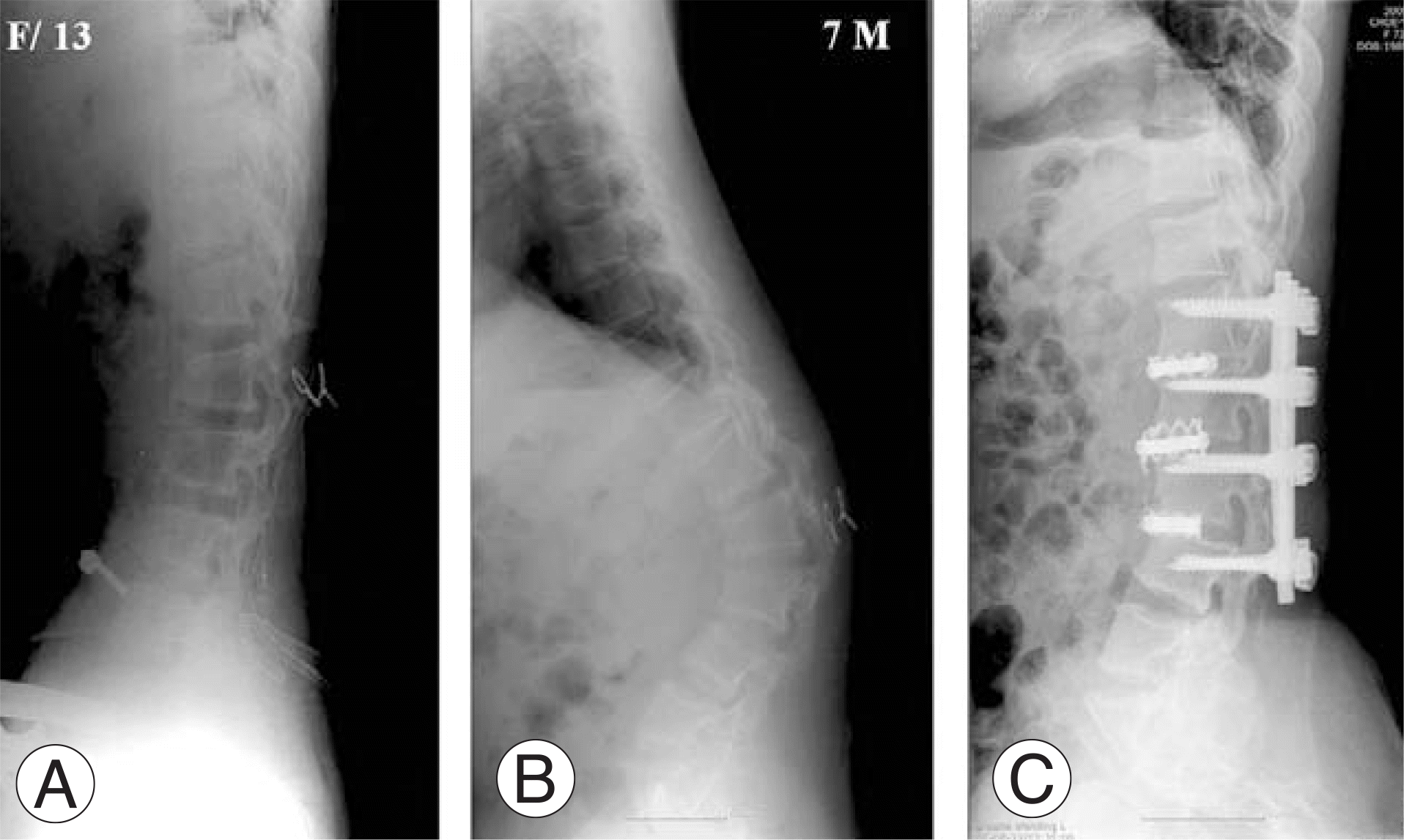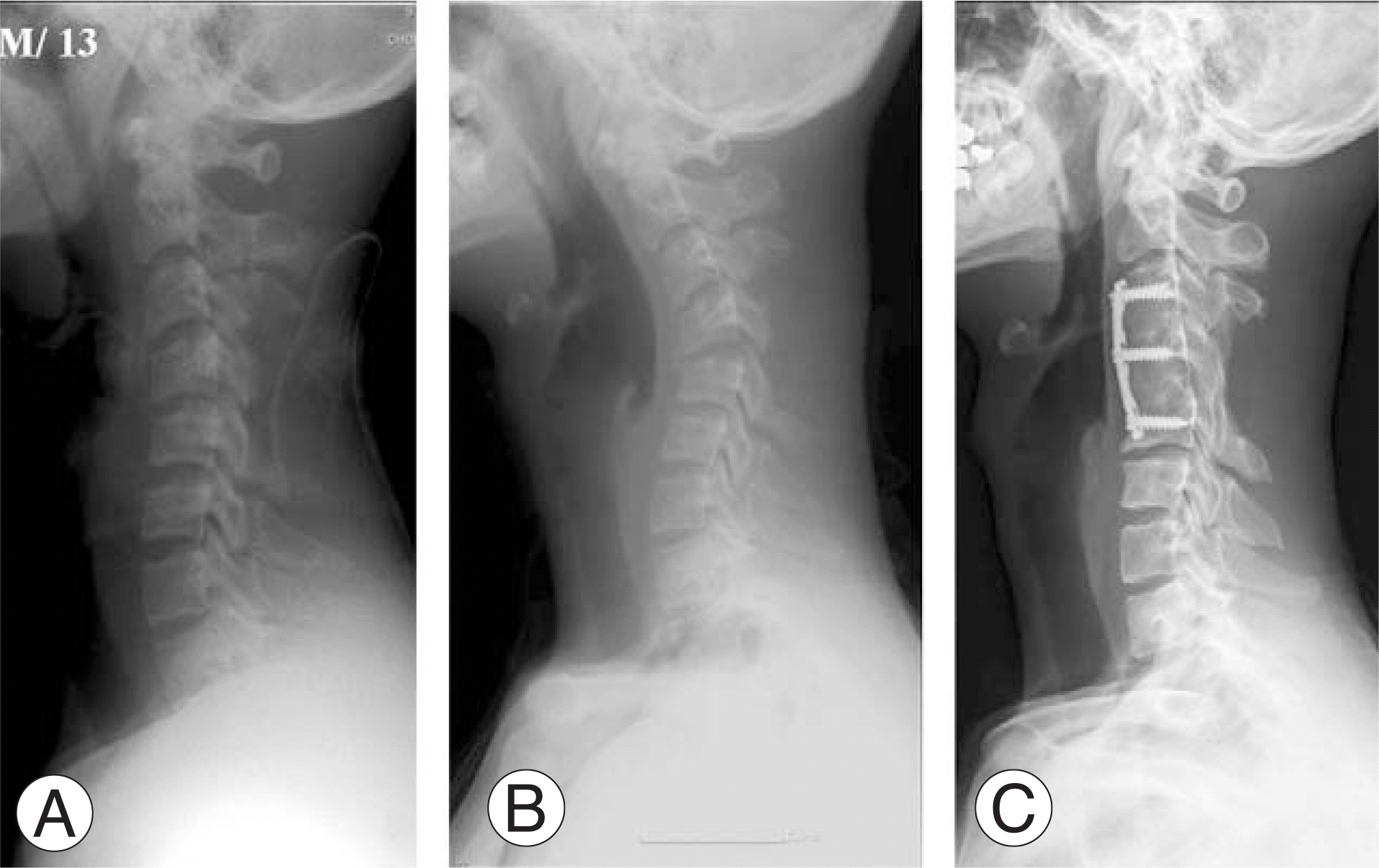Abstract
Summary of Literature Review
Postlaminectomy kyphosis is uncommon and poorly understood, with controversy over the cause, risk factors, and treatment.
Material and Methods
We included 17 patients (8 male, 9 female) who had undergone multilevel laminectomy between 1982 to 2006. Their mean age at the time of laminectomy was 16.3 years. The locations of laminectomy were: 4 cervical/cervicothoracic,10 thoracic/thoracolumbar, and 3 lumbar. Possible factors for developing kyphotic deformities, such as an age at the time of laminectomy, sex, location, laminectomy extent, and radiation therapy were analyzed with the deformity angle and the time interval from the operation to the occurrence of deformity.
Results
The mean time after surgery was 18.3 months, and the mean kyphotic angle was 58 degrees. Patients younger than 12 years or surgery involving more than 4 segments had a slightly shorter time interval, but not significantly. Location had no significant correlation with angle and time interval. Radiation therapy and sex were not significant factors. Most (15) patients received corrective surgery 49.9 months after laminectomy, which reduced deformities to an average of 34.5 degrees, whereas 2 patients had mild curvatures of 38 degrees (mean) One patient received a second operation due to pullout of a rod, and one patient had a postoperative infection.
Go to : 
REFERENCES
1). Albert TJ, Vaccaro A. Postlaminectomy kyphosis, Spine. 1998; 23:2738–2745.
4). Guigui P, Benoist M, Deburge A. Spinal deformity and instability after multilevel cervical laminectomy for spondylotic myelopathy. Spine. 1998; 23:440–447.

5). Katsumi Y, Honma T, Nakamura T. Analysis of cervical instability resulting from laminectomies for removal of spinal cord tumor. Spine. 1989; 14:1171–1176.

6). Zdeblick TA, Zou D, Warden KE, McCabe R, Kunz D, Vanderby R. Cervical stability after foraminotomy: a biomechanical in vitro analysis. J Bone Joint Surg Am. 1992; 74:2005–2008.

7). Breig A, el-Nadi AF. Biomechanics of the cervical spinal cord. Relief of contact pressure on and overstretching of the spinal cord. Acta Radiol Diagn. 1966; 4:602–624.
8). Otsuka NY, Hey L, Hall JE. Postlaminectomy and postirradiation kyphosis in children and adolescents. Clin Orthop Relat Res. 1998; 354:189–194.

9). Kaptain GJ, Simons NE, Replogle RE, Pobereskin L. Incidence and outcome of kyphotic deformity following laminectomy for cervical spondylotic myelopathy. J Neurosurg. 2000; 93(2S):199–204.

10). Papagelopoulos PJ, Peterson HA, Ebersold MJ, Emmanuel PR, Choulhury SN, Quast LM. Spinal column deformity and instability after lumbar or thoracolumbar laminectomy for intraspinal tumors in children and young adults. Spine. 1997; 22:442–451.

11). Blam OG, Albert TJ, Vaccaro AR. Surgical reconstruction of postlaminectomy cervical kyphosis, Curr Opin Orthop. 2002; 13:208–213.
13). Bell DF, Walker JL, O'Conner G, Tibshirani R. Spinal deformity after multilevel cervical laminectomy in children. Spine. 1994; 19:40–411.
14). Ain MC, Shirley ED, Pirouzmanesh BS, Hariri A, Car-son BS. Postlaminectomy kyphosis in skeletally immature achodroplast. Spine. 2006; 31:197–201.
15). Fields MJ, Hoshijima K, Feng AH, Richardson WJ, Myers BS. A biomechanical, radiologic, and clinical comparison of outcome after multilevel cervical laminectomy or laminoplasty in the rabbit. Spine. 2000; 25:2925–2931.

16). Cattell HS, Clark GL Jr. Cervical kyphosis and instability following multiple laminectomies in children. J Bone Joint Surg Am. 1967; 49:713–720.

17). Schultz KD, Mclaughlin MR, Haid RW Jr, Comey CH, Rodts GE Jr, Alexander J. Single-stage anteriorposterior decompression and stabilization for complex cervical spine disorders. J Neurosurg. 2000; 93(2S):214–221.

18). Riew KD, Hilibrand AS, Palumbo MA, Bohlman HH. Anterior cervical corpectomy in patients previously man-aged with a laminectomy: short-term complications. J Bone Joint Surg Am. 1999; 81:950–957.
Go to : 
Figures and Tables%
 | Fig. 1.Postlaminectomy kyphosis in the skeletally immature achondroplast. (A) Radiograph immediate after laminectomy for symptomatic spinal stenosis. (B) Radiograph 7 months after laminectomy shows kyphotic deformity in lumbar spine. Kyphotic deformity can develop in most skeletally immature achondroplast including our case. (C) Radiograph after anterior and posterior fusion for postlaminectomy kyphosis. |
 | Fig. 2.Postlaminectomy cervical kyphosis. (A) Radiograph after laminectomy for removal of cavernous heman-gioma. (B) Radiograph 6 months after laminectomy shows progression of cervical kyphosis. (C) Radiograph after anterior fusion. |
Table 1.
Average time interval from the operation to occurrence of kyphotic deformities after laminectomy.
Table 2.
Average angle of kyphotic deformities after laminectomy at the thoracic spine.




 PDF
PDF ePub
ePub Citation
Citation Print
Print


 XML Download
XML Download